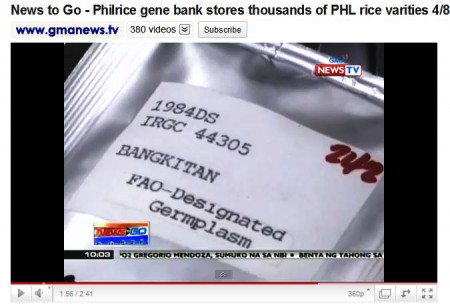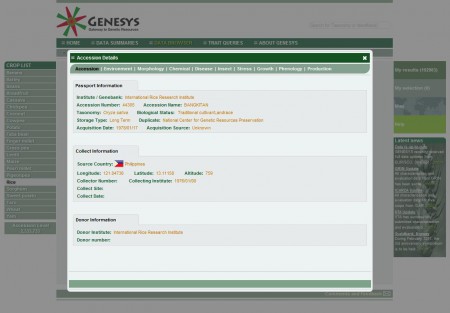I feel a little more needs to be said about the video I nibbled earlier about the Philippine Rice Research Institute (PhilRice) genebank, in particular in light of the questions that were asked at the recent To Serve and Conserve conference about the relative roles of national and international genebanks. Here’s the video again:
I don’t speak Tagalog, but some things are pretty obvious. If you go to 1:57, for example, you get the following shot:

Fortunately, Genesys knows about this IRGC 44503. ((I’m sure IRIS does too, but I couldn’t get it to answer me.)) It’s an IRRI accession, as the IRGC prefix implies:
Now, I understand the need for safety duplication. But for proper safety you’d want it to happen in another country, another continent preferably, and the IRRI and PhilRice are both in the Philippines, although on different islands. ((They are in fact on the same island, as pointed out by Mike Jackson in a comment. Sorry.)) I can also understand that PhilRice might want a sample of IRGC 44503 to hand for research or whatever. But that looks like a seed sample going into long-term storage, and IRRI is not that far. And I understand there’s a measure of historical contingency involved. But things are different now. There’s Svalbard. And there’s the International Treaty on Plant Genetic Resources for Food and Agriculture. So is it really necessary for PhilRice to do long-term storage of an IRRI accession? Couldn’t they leave that to, well, IRRI? It’s not as if they don’t collaborate all the time.
Does it matter? Does it really matter if some rice accessions are kept in long-term stores in several place? Well, for a start it’s not some rice accessions, but many. And not just rice, but many crops. Maybe only about 20% of the world’s 7.2 million accessions are unique, some of those are not duplicated at all, others many times. If you’re trying to work out how much it would cost to conserve, safety duplicate and make available forever that 20%, rather than the full 7.2 million, it most certainly does matter.

Dear Dr. Luigi
The Iraqi gene bank have 43 accessions Oryza sativa are kept in long-term stores and active-term store. Last year we make regeneration like some advance cultivator (AC) and old cultivator (OD) in Diwaniva province south- of -Iraq, one oldest (Jawell) variety couldn’t regeneration because we have 5 seeds only.
There is famous Iraqi variety name Amber 33. Agriculture Minister (India) request 50grm from us (1998) this rice good quality, resistant disease plant.
Just a point of clarification. IRRI and PhilRice are both located on the island of Luzon – not separate islands. IRRI has its headquarters in Los Banos, about 65 km south of Manila. PhilRice is in Munoz, Nueva Ecija, about 200 km to the northeast of Manila.
Regarding the duplication of accessions between IRRI and PhilRice, it seems that the accession shown in the video may well be of Philippine origin – the name suggests that. IRRI had essentially held the Philippines rice collection until PhilRice was founded and its genebank constructed. Once it was operational PhilRice naturally requested a complete set of Filipino accessions from IRRI to hold in its national collection.
The point about ‘over duplication’ is well taken, but national interests and concerns also have to be entered into the conservation equation, even when an international genebank is ‘locally’ available.
Thanks for taking the time to reply, Mike. And sorry about the geographical mistake. You are right, that accession was collected in the Philippines, according to its passport data. And you are also of course right that many different kinds of considerations come into play in designing a conservation programme. The problem comes when you are trying to decide who should pay for what. What I was trying to point out, perhaps too cryptically, is that Parties to the ITPGRFA do have the option now of in a sense “outsourcing” long-term conservation of Annex 1 crops.
It’s clear to me why the Global Crop Diversity Trust wants to see fewer duplicates in genebanks. If it gets to the point where the only remaining copy is held in Svalbard, it will only be released under the SMTA meaning the GCDT will receive royalties on future scientific or breeding use.
What’s not so clear is the argument why otherwise fewer duplicate accessions are better. Surely local genebanks are better able to ensure in-situ use of these accessions than Svalbard or the FAO treaty. As we know, sometimes ‘duplicate’ accessions are not really duplicate, but rather locally adapted or otherwise slightly different varieties. As has already been said there are also local priorities and interests to take into account.
In terms of being ‘cheaper’, surely a world that has enough money to pay for wars in Iraq or Afghanistan or subsidize commodity crops for biofuel or factory farm animal feed could afford the cost of keeping a few genebanks alive if the political will was there. I think it’s a matter of priorities really, and most people consider money spent on genebanks is money well spent.
All species ensure their own survival by making copies of themselves and distributing them, and networks of genebanks are a logical extension to that. In addition to the biodiversity in genebanks it’s important to ensure a diversity of treaties and other conditions that regulate the distribution and use of the materials. Independent plant breeders or small companies have a much harder time functioning when patents or SMTAs are involved, because they have neither the capacity to properly administer these or defend themselves if they end up in court. It’s important everyone has fair access to these materials.
You are of course entitled to your opinion about the motivation of the Trust and other organizations, but I just wanted to point out that there is no connection between use of the SMTA and funding of the Trust. Also, only the genebank that originally deposited a particular set of accessions in Svalbard can ever access those accessions, and an SMTA will not be involved in that process.
@Patrick, I’m sure you don’t mean to sound as naive as you do. You seem to think that money will go where “most people” want it to; I’m not aware of any examples of that. Not even in things like development aid, or the fight against hunger. I’m not even sure “most people consider money spent on genebanks is money well spent”. In fact, I’d say that most people have no idea what genebanks actually are, or what they cost.
In fact, I am willing to bet that, as with US foreign aid, most people vastly overestimate how much is spent on genebanks, and say that the amount that ought to be spent is greater than the amount actually spent.
I’m also not aware of a single species that ensures its own survival. Can you point me to one, please?
Jeremy: You’re reading too much into what I said. My point was simply that of those people aware of the existence of genebanks, not many are calling for funding cuts.
Tell that to those responsible for Brogdale, Wellesbourne, Pavlovsk…
It seems to me as far as Pavlovsk goes, as soon as it started to get attention there was not only interest in preserving it, but also establishing better and longer term funding. No?
Ah! Humpty Dumpty strikes again.
And Pavlovsk is certainly no more secure today than it was when it started to get attention.